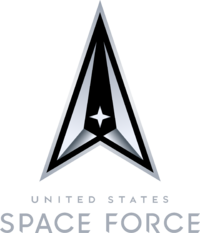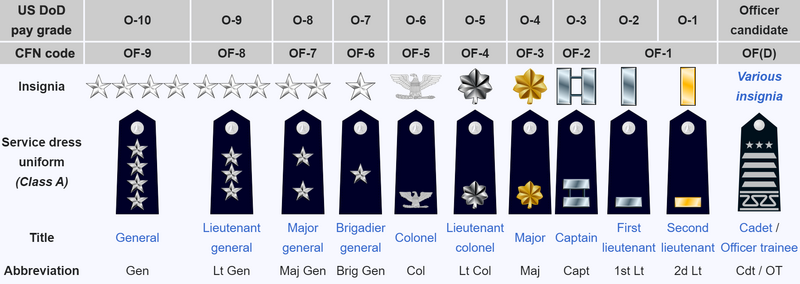United States Space Force: Difference between revisions
Zeromanicus (talk | contribs) mNo edit summary |
Zeromanicus (talk | contribs) |
||
| Line 89: | Line 89: | ||
The United States Space Force operates a number of commands. The most important of which is the center of civilian administration, the Octagon. | The United States Space Force operates a number of commands. The most important of which is the center of civilian administration, the Octagon. | ||
{| class="wikitable | {| class="wikitable" | ||
! Headquarters | ! Headquarters | ||
! Major Commands | ! Major Commands | ||
| Line 107: | Line 107: | ||
=== Personnel === | === Personnel === | ||
The United States Space Force employs millions of civilians and military personnel. | The United States Space Force employs millions of civilians and military personnel. | ||
{| class="wikitable | {| class="wikitable" | ||
! Total active personnel | ! Total active personnel | ||
! Reserve personnel | ! Reserve personnel | ||
| Line 119: | Line 119: | ||
===Fleets=== | ===Fleets=== | ||
The USSF Operates four principle fleets, each assigned to a particular sector command. | The USSF Operates four principle fleets, each assigned to a particular sector command. | ||
{| class="wikitable | {| class="wikitable" | ||
! Fleet !! Base !! Region !! Composition | ! Fleet !! Base !! Region !! Composition | ||
|- | |- | ||
| Line 152: | Line 152: | ||
===Ship Classes In Service=== | ===Ship Classes In Service=== | ||
{| class="wikitable" style="width: 60%; | {| class="wikitable" style="width: 60%; | ||
|+ USSF Ship Classes in Service | |+ USSF Ship Classes in Service | ||
|- | |- | ||
| Line 170: | Line 170: | ||
|} | |} | ||
{| class="wikitable" style="width: 60%; | |||
{| class="wikitable" style="width: 60%; | |||
|+ US Marine Corps Ship Classes in Service | |+ US Marine Corps Ship Classes in Service | ||
|- | |- | ||
Revision as of 11:10, 1 July 2024
| United States Space Force | |
|---|---|

| |
| Logo of the United States Space Force | |
| Founded | 20 December 2019 |
| Country | United States |
| Allegiance | United States of America |
| Branch | United States Armed Forces |
| Type | Space force |
| Role | Space warfare |
| Size | 180 Starships |
| Headquarters | The Octagon Columbia, Eisenhower, U.S. |
| Motto | Semper Supra Template:Small |
| Colors | [Colors as of 2326] |
| March | [Semper Supra] |
| Equipment | [List Pending] |
| Engagements | [Major engagements by 2326] |
| Commanders |
|
| Notable commanders | [Names of notable past commanders] |
Overview
United States Space Force (USSF)
The United States Space Force (USSF) has evolved significantly since its inception in the early 21st century, becoming a formidable branch of the U.S. military by the 23rd century. As humanity expanded into the stars, the USSF adapted to meet the challenges of interstellar warfare and diplomacy.
Marine Corps Component
A significant component of the USSF is its Marine Corps. The United States Marine Corps was transferred from the Office of the Navy to the Office of the Space Force in the 22nd century, as the importance of interplanetary warfare rose. The Marine Corps has significant integrated elements including 8 Marine Escort Squadrons and 8 Light Support Flotillas. These forces are specialized for planetary assault and defense operations, with 2 Orbital Dominance Groups for space-to-ground support and 4 Marine Assault Groups for direct planetary intervention.
Culture and Doctrine
The USSF operates much like the USN in terms of it's military culture and traditions. Though there are certain differences, such as Astrogation Officers instead of Navigation Officers. With operations spanning multiple star systems, USSF personnel are trained to be adaptable and self-reliant.
Given the strategic importance of T-Gates and the complex interstellar political landscape, the USSF plays a crucial role in both military operations and diplomacy. Its presence across human-controlled space serves not only as a deterrent to potential adversaries but also as a visible representation of U.S. power and influence.
The USSF's doctrine emphasizes flexibility and combined arms operations, integrating space, air, and ground assets for both orbital and planetary missions. This holistic approach to space warfare reflects the complex nature of interstellar conflicts and the need to protect U.S. interests across multiple fronts.
History
Foundation and early years (2019-2100)
[Your content here]
Expansion era (2100-2200)
[Your content here]
Modern era (2200-present)
[Your content here]
Organization
Organizationally, the USSF is structured around its fleet composition, which includes a mix of powerful capital ships and smaller, more nimble vessels. At the core of the fleet are 12 Supercarrier Battle Groups, each centered around a massive USSF Supercarrier. These are supported by 8 Heavy Cruiser Squadrons and 12 Large Escort Squadrons, forming the backbone of the USSF's deep space combat capabilities. For more specialized roles, the USSF maintains 8 Scout Escort Flotillas and 4 Cruiser Pickets, designed for reconnaissance and rapid response missions.
The United States Space Force operates under four principle commands, each covering a region of the grid with a headquarters located on Jewel system.
Structure
The United States Space Force operates a number of commands. The most important of which is the center of civilian administration, the Octagon.
| Headquarters | Major Commands |
|---|---|
| The Octagon |
|
Personnel
The United States Space Force employs millions of civilians and military personnel.
| Total active personnel | Reserve personnel | Civilian personnel |
|---|---|---|
| [Number as of 2326] | [Number as of 2326] | [Number as of 2326] |
Fleets
The USSF Operates four principle fleets, each assigned to a particular sector command.
| Fleet | Base | Region | Composition |
|---|---|---|---|
| 1st Fleet | Fleet Base Elysium | Eta Cass Sector |
|
| 2nd Fleet | Fleet Base Armstrong | Sol Sector |
|
| 3rd Fleet | Fleet Base Terranova | Iota Persei Sector |
|
| 4th Fleet | Fleet Base Prospect | Zeta Tucanae Sector |
|
Ship Classes In Service
| Class Name | Description |
|---|---|
| John F. Kennedy Class Supercarrier | The venerable John F. Kennedy class was first laid down in the late 2290s, evolving from the pre-Yellowstone Roosevelt class. These vessels serve as the backbone of USSF fleet operations, incorporating jump shunt technology and serving as mobile command centers for entire battle groups. Twelve are currently in service, with two more planned. They are notable for their retro interior designs, featuring what appears to be wooden paneling and brass fixtures evoking an elegant interpretation of the age of sail. |
| Columbia Class Heavy Cruiser | While USSF doctrine emphasizes carrier-based operations, the Columbia class serves as a versatile heavy cruiser capable of independent action and fleet support. These ships excel in planetary orbital defense and as powerful escorts for carrier groups, with their balance of firepower and durability. |
| Wasp Class Landing Ship | Purpose-built for planetary assault operations, the Wasp class combines rapid troop deployment capabilities with robust defensive systems. These ships feature advanced gravity manipulation technology for precision landings and heavy equipment deployment. |
| New California Class Light Cruiser | The New California class serves as a versatile platform for reconnaissance, patrol, and light combat duties. These ships feature advanced sensor suites and modular mission packages, allowing them to adapt to various operational requirements. |
| Valdez Class Frigate | Designed for escort and rapid response missions, the Valdez class combines speed with a potent array of defensive and offensive systems. These ships often operate in wolf packs, providing screening for larger vessels and conducting independent patrols. |
| Phantom Class Electronic Warfare Frigate | Specializing in electronic warfare and signals intelligence, the Phantom class represents the cutting edge of USSF electronic combat capabilities. These ships feature advanced jamming systems, cyber warfare suites, and stealth technology. |
| Class Name | Description |
|---|---|
| Butler Class Destroyer | The Butler Class Destroyers form the backbone of the USSF's Large Escort Squadrons. These vessels are heavily armed and armored, designed to protect larger ships from enemy threats. With advanced radar and missile systems, they excel in both offensive and defensive operations, providing a robust screen for carriers and battleships. Fast and versatile, Butler Class Destroyers are capable of independent operations or integrating seamlessly into larger fleet actions. |
| Tarawa Class Support Ship | The Tarawa Class Support Ships are the lifeline of the fleet, forming the core of the Light Support Flotillas. Equipped with state-of-the-art replenishment and repair facilities, these vessels ensure that front-line ships remain operational during extended deployments. The Tarawa Class includes tankers, cargo ships, and medical vessels, all designed to support combat operations far from home. Their ability to provide fuel, supplies, and medical aid makes them indispensable in prolonged engagements. |
| Belleau Wood Class Assault Carrier | The Belleau Wood Class Assault Carriers are designed for the ultimate objective: achieving orbital dominance. These ships serve as the central hub of the Orbital Dominance Group, capable of launching extensive ground assault operations. With advanced electronic warfare capabilities and powerful orbital bombardment systems, Belleau Wood Class Assault Carriers clear the way for troop deployments and maintain control of the orbitals around contested worlds. They are heavily fortified to withstand counterattacks, ensuring the successful insertion and support of ground forces. |
| Tripoli Class Interface Assault Ship | The Tripoli Class Interface Assault Ships are at the forefront of the USSF's Marine Assault Groups. Specially designed to transport and deploy USSF Marines, these ships are equipped with dropships and vertical take-off and landing (VTOL) aerospace craft. They provide essential support for Interface operations, allowing rapid deployment of ground forces onto hostile planets. The Tripoli Class is built to withstand direct enemy fire while delivering Marines safely to their objectives, embodying the courage and resilience of the USSF Marines. |
Ranks and insignia

|
See also
- United States Army
- United States Navy
- United States Air Force
- United States Marine Corps
- United States Coast Guard
References
<references/>